
Salmon is the common name for several species of ray-finned fish in the family Salmonidae. Other fish in the same family include trout, char, grayling, and whitefish. Salmon are native to tributaries of the North Atlantic and Pacific Ocean. Many species of salmon have been introduced into non-native environments such as the Great Lakes of North America and Patagonia in South America. Salmon are intensively farmed in many parts of the world.

Mackerel is a common name applied to a number of different species of pelagic fish, mostly from the family Scombridae. They are found in both temperate and tropical seas, mostly living along the coast or offshore in the oceanic environment.

The muskellunge(Esox masquinongy), often shortened to muskie, musky or lunge, is a species of large freshwater fish native to North America. It is the largest member of the pike family, Esocidae.

Sciaenidae are a family of fish in the order Perciformes. They are commonly called drums or croakers in reference to the repetitive throbbing or drumming sounds they make. The family consists of about 286 to 298 species in about 66 to 70 genera.

Characiformes is an order of ray-finned fish, comprising the characins and their allies. Grouped in 18 recognized families, more than 2000 different species are described, including the well-known piranha and tetras.
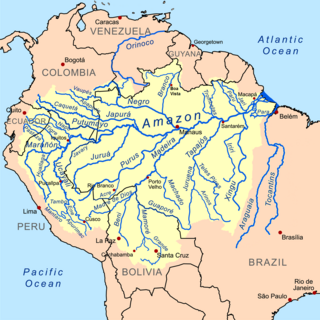
The Amazon basin is the part of South America drained by the Amazon River and its tributaries. The Amazon drainage basin covers an area of about 6,300,000 km2 (2,400,000 sq mi), or about 35.5 percent of the South American continent. It is located in the countries of Bolivia, Brazil, Colombia, Ecuador, French Guiana (France), Guyana, Peru, Suriname, and Venezuela.

The salmon run is the time when salmon, which have migrated from the ocean, swim to the upper reaches of rivers where they spawn on gravel beds. After spawning, all Pacific salmon and most Atlantic salmon die, and the salmon life cycle starts over again. The annual run can be a major event for grizzly bears, bald eagles and sport fishermen. Most salmon species migrate during the fall.

Yucca filamentosa, Adam’s needle and thread, is a species of flowering plant in the family Asparagaceae native to the southeastern United States. Growing to 3 m (10 ft) tall, it is an evergreen shrub valued in horticulture for its architectural qualities.
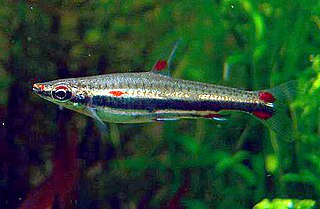
The pencil fishes are a family (Lebiasinidae) of freshwater fishes found in Costa Rica, Panama, and South America. They are usually small and are known as ornamental fishes in aquaria, including popular fishes such as the various pencil fish and the splashing tetra.

The Arulius barb is a tropical cyprinid fish native to the Kaveri River basin of south east India. Other common names include Tamiraparani barb, Silas barb and longfin barb.

Cutthroat eels are a family, Synaphobranchidae, of eels, the only members of the suborder Synaphobranchoidei. They are found worldwide in temperate and tropical seas.
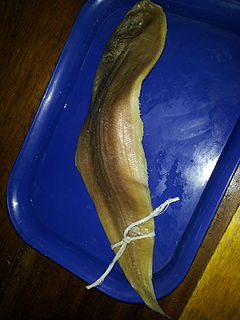
Tonguefishes are flatfish in the family Cynoglossidae. They are distinguished by the presence of a long hook on the snout overhanging the mouth, and the absence of pectoral fins. Their eyes are both on the left side of their bodies, which also lack a pelvic fin. This family has three genera with a total of more than 140 species. The largest reaches a length of 66 cm (26 in), though most species only reach half that size or less. They are found in tropical and subtropical oceans, mainly in shallow waters and estuaries, though some species are found in deep sea floors, and even a few in rivers.

Hara is a genus of South Asian river catfishes native to South Asia from India to Myanmar.

Cavefish or cave fish is a generic term for fresh and brackish water fish adapted to life in caves and other underground habitats. Related terms are subterranean fish, troglomorphic fish, troglobitic fish, stygobitic fish, phreatic fish and hypogean fish.

Hara hara is a species of South Asian river catfish that occurs in Bangladesh, China, India, Myanmar and Nepal. This species grows to a length of 13.0 centimetres (5.1 in) TL.
Hara horai is a species of South Asian river catfish endemic to West Bengal, India where it is found in the Terai and Duars in the middle and upper Brahmaputra River drainage. This species grows to a length of 8 centimetres (3.1 in) TL.
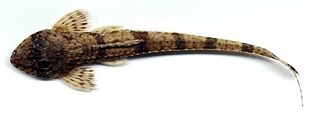
Whiptail catfish is a species of armored catfish endemic to Colombia where it is found in the Magdalena River basin and is suspected to also occur in the Catatumbo River. This species grows to a length of 26 centimetres (10 in) SL. D. filamentosa is found in the aquarium trade.

Dawkinsia filamentosa is a species of barb. Young fish have barely any color and black spots. They start having more color at three months old. The fish is a swift swimmer. Males are larger than females and they fertilize eggs by swimming into the cloud of eggs. The species is most commonly found in coastal floodplains near the Southwest Indian states of Kerala, Tamil Nadu and Karnataka. The species' common names are filament barb and blackspot barb.
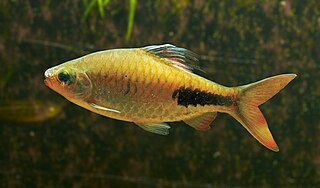
Dawkinsia is a genus of cyprinid fishes from freshwater in South India and Sri Lanka. It was recently split off from genus Puntius.
Gymnochanda is a genus of fishes in the family Ambassidae, the Asiatic glassfishes. They are native to turbid fresh water habitats near peat or swamp forests in Peninsular Malaysia, Borneo, Sumatra and Belitung Island.
















